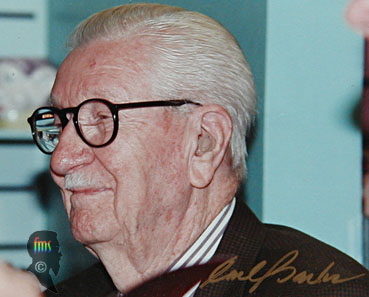

Carl Barks
Text and photographs © by Frank Stajano
In my life I had the great privilege not only of growing up on Barks's comics but also of meeting the man who created them. I have decided to split this page into two parts: a more formal presentation of this outstanding author, and a more personal view of my relationship with him.
Who is Carl Barks? To me, the greatest comics author of all times, and one of the giants of 20th century literature. I don't expect this assessment to be universally shared, but I also know I'm not alone in thinking this.
Few will argue with the fact that Barks, with Floyd Gottfredson a close second, was the best comics author that the Walt Disney company ever had. He turned Donald Duck from a slapstick comedy cartoon character to an all too real human being (albeit duck shaped) in whose traits readers could recognise their friends -- and themselves.
As he breathed new life into the characters he inherited from the animation and the daily strips, Barks also created memorable new ones: Uncle Scrooge McDuck, the Beagle Boys, Gyro Gearloose and his helper, Magica de Spell, Gladstone Gander, the Junior Woodchucks -- just to name the most famous. It is doubtful that the world of Disney comics would have ever developed to the extent that it has without Carl Barks's masterpieces, which attracted and inspired a critical mass not only of readers but also of other authors, from all over the world.
One of a minority of comics authors who developed both the plot and the artwork for his stories, Barks came into Disney comics from Disney animation, where his strengths were gags and plot. Echoes of this may be felt in his stories, which are much more elaborate and entertaining than animated cartoons, but break the tension with lighthearted gags at just the right moment.
Carl Barks did not have the privilege of attending higher education:
born in a Far West ranch (Merrill, Oregon, 1901-03-27), he only went
to school until the age of fifteen. As he retells himself in Michael
Barrier's excellent book [1], he had already been
working at farming errands since his pre-teens (worshipping the tough
cowboys who brought the cattle to the train wagons), and at fifteen
the daily pay as a farmer's helper (five dollars -- not a trivial
amount in WWI days) was too good to miss.
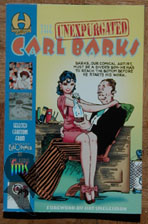
Though he already cherished the thought of becoming a cartoonist, he went through a long string of unrelated jobs, from errand boy for a printing outfit to riveter at a railroad repair shop. Only at the end of the 1920s did he manage to sell his first gag cartoons to the Calgary Eye-Opener, a satyrical magazine that later employed him full time. (Some of these early pre-Disney works have been recently reprinted by Gladstone [4].)
He arrived at Disney in 1935 where, like most, he started as an in-betweener -- the junior artist who draws the intermediate positions of an animated cartoon character, after a more senior artist has drawn the initial and final frames of the movement. His wits and creativity soon got him promoted to gag man, then to script man. He left the Studios in 1942, not least because of a sinus problem aggravated by the heavy air conditioning, and started a chicken farm.
The phase of his career in which he would produce his true masterpieces started shortly afterwards, when he began to work from home as a freelance on Donald Duck comic books for Western Publishing. From that moment until his retirement in 1966, Carl Barks devoted himself to what he did best: storytelling. His stories were the delight of children all the world from many generations: many lucky kids learnt to read over the pages of his comics. But these stories, in their simplicity and greatness, were not kiddie stuff. Those same kids would grow into teenagers and keep on reading them with continued interest, discovering new beauties in them. And then they would grow into adults and rediscover them, perhaps after a long break, or perhaps having never abandoned them, and they would still find them every bit as exciting, entertaining and addictive as their favourite grown-up novels.
Carl Barks never attempted nor intended to build layers upon layers of hidden meanings in his works; yet readers of all ages could enjoy his stories, each one of them finding something of beauty in it at the appropriate level for his or her age. He was one of the great storytellers of world literature, and it was natural to him to tell a story that all of his readers could enjoy and relate with. His outstanding ability to render his ideas visually with his distinctively neat and elegant stroke -- all too often imitated and never equalled -- was nothing compared to his gift for storytelling and for the fantasy and imagination of his ideas. He had a kind, gentle heart, and he was blessed with the touch of the genius.
Despite his lack of formal education he was a man of great culture, active curiosity, extremely sharp wit and outstanding creativity. Most fans already know it, but some will be surprised to find out that, despite having staged and drawn so many epic adventures in faraway lands, from ancient Egypt to Scotland and from the Himalaya to the bottom of the ocean, he only first ventured outside America when he was 93 years old! As he wrote to me before that trip:
In my 92 years I have never been farther from American soil than Ensenada, Mexico and Victoria, B.C., Canada. All those far away locales for the duck's adventures were fabricated from pictures I saw in geographic magazines.
In the first volume of the first set of the Carl Barks library [3], Thomas Andrae and Geoffrey Blum offer an
interesting side-by-side comparison of National Geographic pages and
Barks panels.
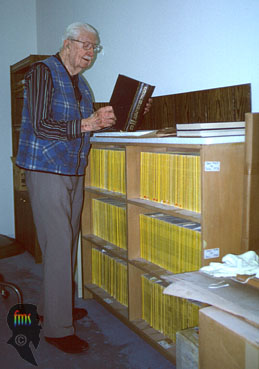
If you already know and love Carl Barks, you don't need my words to persuade you that he was the greatest -- you knew that already. But if you are reading this because you are intrigued by this "Duck Man" artist you had never heard of before and you want to find out more about him, then instead of reading any more of my ramblings your time would be better spent enjoying some of his masterpieces for yourself, so as to form a first-hand opinion.
Barks's production was of such consistently high quality that recommending specific "good stories" is a hard job -- there are too many of them! (If you are totally new to the Disney comics universe, it may of course take a few stories before you become familiar with the personalities of the characters.) Nonetheless, for those who might feel lost among the hundreds of stories he produced, I shall list some great classics below. Each one of them would deserve its own essay, but I'll shut up. [In due course I shall add here a list of great stories and reproductions of pages from these stories.]
Barks's wife Garé was a painter. When Barks retired he learnt a bit
about oils and brushes from her and started painting as a hobby,
eventually getting to portray his very own ducks. These oil paintings
(over the years he produced over a hundred of them) were pretty and
charming on their own but, artistically and semantically, they paled
into insignificance compared to the comics stories which are Carl
Barks's real masterpieces. Nobody would have ever paid any attention
to the paintings if he had not written the stories. The paintings were
significant not on their own, but because they were a part of the Carl
Barks legend. It is ironic that they would end up fetching six-digit
dollar prices at auctions and eventually bring him some of the
financial recognition that his immortal stories never gave him.
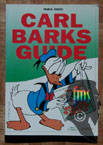
Until comparatively recently, the policy of the Disney company was never to disclose the identities of the authors of its comics. Barks, therefore, remained anonymous for the whole of his comics career. His readers, however, could definitely tell his stories from the rest and, despite the anonymity, dubbed him "the Good Artist". There is an unmistakable quality about his stories that few can miss. Fortunately, Disney publishers and licensees all over the world seem to have understood this, and reprints of Barks stories are plentiful in many languages. In order to find any particular story in which you might have an interest, an invaluable resource is the Inducks database, developed by a team of contributors from all over the world (of which I am a proud member) and co-ordinated by Harry Fluks. An online version of it can be queried from the pages of the Disney Comics mailing list. If you read Italian, an even more comprehensive resource is the essential reference work by Franco Fossati, Carl Barks Guide [2], which contains a fully cross-referenced chronological index of all of the Barks stories (each with a helpful summary and many with a little picture) and their Italian reprints; the text of this book is also available online at Marco Barlotti's web site, courtesy of the Franco Fossati foundation, and was published in a gazillion installments (thereby defeating most of its usefulness, but never mind) in the back pages of the monthly comic Zio Paperone.
While reprints of individual stories are plentiful, what is difficult to come by is an organic collection, available as a unit, reprinting the complete works of the Master. Such a thing exists, but has long been out of print: the Carl Barks Library [3], in 30 luxurious hardbound volumes, presents all of his Disney stories in a large format that really does them justice, together with insightful commentaries by outstanding Barks scholars such as Geoffrey Blum, Donald Ault and Thomas Andrae. Sadly, it is very difficult to obtain. It took me ten years to buy the entire series, chasing the book sets one by one in about half a dozen different cities around the world. Nowadays it is almost impossible to acquire it as a complete set. Several Disney licensees around the world print Barks material regularly, if rarely chronologically (I am most familiar with Gladstone's softcover Carl Barks Library in Colour and with Zio Paperone, perhaps the best comic in the Italian Disney scene, but I have copies of several others coming from France, Greece, Scandinavia and more; and my friend Chuck Munson once showed me some even more exotic Barks reprints of which I couldn't even read the script), so one may end up with a complete set of Barks stories at a reasonable price by buying all the issues of the appropriate comic for so many years. But this solution, too, is less than satisfactory; partly because, except in the Gladstone case, the stories are mediated by the translation; but more importantly because even so it still is impossible for an interested reader to go to a bookstore (or to write to a mail-order publisher) and buy an edition -- any edition -- of the complete works of Carl Barks.
I look forward to the day when Carl Barks will get the recognition he deserves as one of the great authors of 20th century literature, and I hope that this will bring along the availability of affordable reprints of his complete works. I don't expect his complete works to be something that every household has, just like not every household has the complete works of Plato or Shakespeare or Mozart or Chaplin. On the other hand I do think that the complete works of Barks should be, like those of Plato, Shakespeare, Mozart, Chaplin and of many other great Masters who left us the fruit of their genius, something that anyone who wants can reasonably obtain from a bookshop, and certainly something that one could legitimately expect to find in a public library.
This is nothing like a complete bibliography on Carl Barks -- which would have to list several other books and a wealth of fanzine and magazine articles. I am only giving the full references for the texts cited above.
The first and still the most important book ever written about Carl Barks. Barrier's fundamental work combines biography, criticism and a (now surpassed) story index. The commentary, acute and insightful, would be enough to make this volume praiseworthy, but the greatest asset of the book is its wealth of first-hand material: photographs and sketches are plentiful, and a substantial part of the text consists of Barks's own spontaneous and witty prose (from letters and interviews), telling about himself in his own words. Unfortunately out of print, this is nevertheless a book that no Barks fan should miss.
A useful chronological index of all of Carl Barks's stories, with summaries, pictures, reprints and cross-references.
A splendid black and white critical edition, in 30 large-format hardbound volumes, of all the Disney stories by Carl Barks, complemented by excellent essays and interviews. The ultimate first-hand Barks reference.
An inexpensive little booklet with selected (recoloured) cartoons from Barks's pre-Disney career at the Calgary Eye-Opener. Interesting documentation..
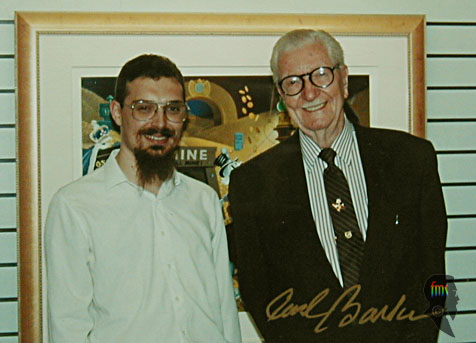
One day of many years ago I decided that I couldn't be so lucky as to be alive at the same time as Carl Barks without letting him know how grateful I was for the joy he had given me with his masterpieces, so I decided to write him a letter.
Of course I had no idea of where to send it, so I tried inquiring at the Walt Disney company in Burbank, California. I got a polite reply saying that they could not give out the personal addresses of any of the artists (fair enough) but that I could send my letter to them and they would forward it. I had not done this before because I feared that by writing to Carl Barks c/o Disney the letter might just be filed away in some archive without him ever seeing it. But when they explicitly told me that they would pass it along, I went ahead.
I knew that my hero was in his nineties and I imagined that, with the
number of people in the world who loved his stories, he would get
several such messages a day; so I certainly did not expect a personal
reply. I was just happy for him to know that, somewhere on another
continent, there was yet another reader who really, really liked his
work.
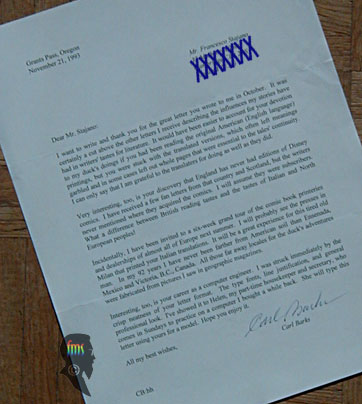
I can't even begin to describe how surprised, excited and happy I was when, some time later, I received a letter from him! It's just beyond words. This man, one of the greatest authors of our century, and one of the people I admired most in the world, had taken the time and trouble to write a personal letter to a nobody like me! I was over the moon.
We exchanged a few more letters and then, in 1994, I finally got a chance to meet him when he visited London as part of his seven-week tour of Europe -- he was 93 years old and this was the first time in his life that he was out of America! In fact he later wrote to Italian Disney author Carlo Chendi that he was happy to have been able to do this trip "while he was still young". And he was indeed: he was in excellent physical shape, stood tall and straight, and walked without a cane. (During that tour, while in Italy he even piloted a motor boat in Lake Como!) He reminded me very much of my own grandfather who was slightly older than him (born in 1898) and was at the time still equally fit, going out for his regular walk every day.
His visit to that Disney store in London resolved into a two-hour signing session, with people queuing up to get his autograph on a comic or on one of the leaflets that were available in store advertising the latest lithograph from one of his paintings -- a long, horizontal one, based on the Golden Fleecing story, that I would see again years later in his living room. I asked him to sign the large hardbound volume of Uncle Scrooge stories that was one of my most prized possessions when I was little. I also took some photographs of him and I got an employee of the store to take one of us together. I later send him double copies by mail and he returned mine signed. I then framed them and hung them in my living room, where they have been since.
Getting to meet him in person was at first perhaps even more extraordinary than receiving the letter: there he was, in the flesh, smiling at me. Wow! I was so thrilled, even if my quota of time next to him was only of a couple of minutes or so. I barely had time to say my name (so that he could write it in the dedication) and that I loved his stories, and then it was the turn of the next person in the queue. He later wrote to me that, unsurprisingly, he had not realised who I was, but that he made the connection when he got the pictures in the mail.
Many things happened over the next few years and I lost touch with him. I later learned that his "managers" intercepted his mail and that I must have been a dodgy character to their eyes because of my association with Don Rosa, whom I even visited in 1996 when I was writing a book about him with Leonardo Gori and Alberto Becattini. In retrospect, this explains why I no longer received any replies from Carl Barks during that period. I shall not go into the sad details of the whole story of the Carl Barks Studio, but suffice it to say that it all ended up in court and that the bad guys eventually disappeared, to everyone else's relief. Those who know the background appreciate the "champ" back cover of Uncle Scrooge 314, which says it all without the need for words.
In my next letter I suggested to Carl Barks that, now that circumstances had changed, the time might be right for a meeting with Don Rosa, who had always been one of his most devoted fans. This happened a little later: my friend Michael Naiman, another great fan of both authors, accompanied Don in his visit to Carl's home in Grants Pass, Oregon, and wrote a brief but inspired article about the meeting which apppeared in what unfortunately turned out to be the next-to-last published issue (317) of Uncle Scrooge. (I hope that I will have to correct this last sentence in the future.)
It was at Michael's home in San Diego in 1998 that I first heard about Gerry Tank. Michael had been arranging for Barks fans from all over the world to send in little notes for Carl's 97th birthday. He collected all the cards and ancillaries (someone had even sent a bottle of liquor) in a big parcel that he forwarded to Gerry in Grants Pass, who would take Carl out to dinner for his birthday and deliver the surprise box to him. Gerry had been the doctor of Carl's wife Garé; he lived not far from the Duck Man and visited him regularly. On the day I arrived at Michael's, him and Gerry had an animated telephone conversation about some incredible problems, worthy of Donald Duck's worst day, that had sent this important parcel missing (I am over-simplifying). To anyone whose birthday card was in that bundle: you have no idea of what Michael and Gerry went through to ensure that it would be delivered against all odds! But all went well in the end, and Carl was very pleased to feel the warmth and affection of so many fans he almost didn't know he had.
Gerry and I then got in touch via email. Leonardo Gori and I were writing another book on Disney comics, this time focused on Mickey Mouse author Floyd Gottfredson. I sent Gerry a list of questions we had prepared and he interviewed Carl for us. That, too, was a brilliant experience, despite the indirection.
But the best was yet to come. Later that year I had to visit the
States again to speak at a conference; so, with Gerry's invaluable
logistic help, I took a detour to Oregon for the weekend to visit my
hero. The plane that was meant to take me from New Jersey to Oregon
had a malfunction in midflight, so we were flown back to Newark and I
had to get on a plane to California the next day, and then on a
connecting flight to Oregon. I felt of course damn lucky not to have
crashed (!) but I was also furious that this unique chance to spend
some time with Carl Barks was being cut short. After repeated airport
delays, and too many phone calls to my patient contact, I finally
landed in Medford, Oregon where Gerry had come to pick me up. He drove
me to Grants Pass, I checked into a local motel and we finally arrived
at Carl's home in mid-afternoon.
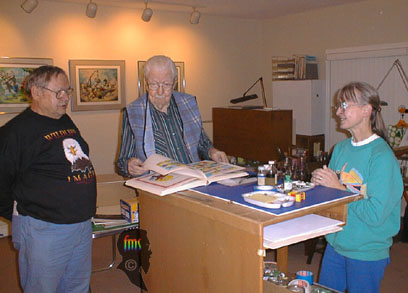
You can well imagine that at that point I was essentially in paradise. Carl was in excellent shape and welcomed Gerry and me into his living room. Betty, one of his helpers, was also there. I was almost petrified with joy. We started to talk about this and that, I retold my adventure of the broken plane that had to make a U-turn in midair, then Carl asked about the conference that I was going to attend next and I opened my bags to show them the large laminated posters I had prepared for it. I also started to take out a variety of silly presents that I had brought along: I felt that this man had given me so much that I wanted to bring in the moral equivalent of an Easter egg the size of a large safe! As we were back chatting in the armchairs after I had spread the content of my suitcases over the floor of his living room, he suggested that I bring my luggage downstairs. I explained that I had already checked in at the Super-8 Motel (I still have their plastic card from that afternoon, by the way) and that we had only brought the suitcases along because they were full of this stuff that was meant for him. At that point he insisted in the friendliest of ways that I should be his guest and stay at his house, that he had plenty of room, that there was absolutely no reason for me to stay elsewhere and that I should cancel my booking at the motel.
So I was taken downstairs to the suite that had been Garé Barks's,
with Carl assuring me that I would be fine here, and I just could not
believe it. Could not believe it! Come on, I'll take a real
plane crash if that's what I get afterwards! If I had felt like
entering paradise when he greeted me on his front door with his
friendly smile, now I was being taken to the highest clouds and given
the golden keys by the boss!
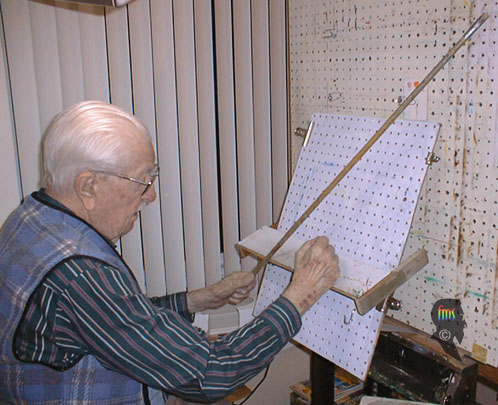
Carl then took us to his study; it was very luminous despite being one floor down from the main entrance, because the house was built on a hill. Brushes and painting colours everywhere. Framed duck pictures on the walls, but he explained that they were only lithographs (he only had one original duck painting in the entire house). By far the most impressive item in the room was Carl's famous easel, seen in so many photographs, made of white perforated board of the kind normally used to hang power tools to the garage wall. In the style of Gyro Gearloose, Carl had designed and customised it to make it suit his work style and his necessities. A smaller perforated panel could be used to hold smaller paintings at an angle. A movable "balcony", a bit like the gizmo used by New York window cleaners, could be positioned in the most comfortable place across this panel to act as a hand rest. "My hand is no longer that steady", he explained, "but if I rest it on this I can still work on the fine details." And finally the cutest trick of all: a long wooden stick ending in a hook that he could attach to any hole on the board to provide an easily moved support. This allowed him to reach any point of a large painting without going to the trouble of detaching and repositioning the "balcony".
His study was also full of comics with his stories, not only the American ones but also many foreign editions, including the large hardbound Io, Paperone that I had brought for him to sign in London (this is the volume he is leafing through in the picture with Gerry and Betty), as well as translations of these Italian Mondadori volumes from the Seventies in many other languages. At my request we then visited the back room where he kept his famous collection of National Geographic magazines (I thought of my grandmother, a miniaturist painter, who used to love them too, and she had almost as many). What a thrill to see the magazines that had taken Carl Barks's mind around the world, in preparation for the adventures of his ducks!
That same afternoon Betty took me into town with the car, first to the motel to cancel my reservation and then to a Radio Shack to buy a power supply for one of the toys I had brought for Carl. The British power supply that came with the gadget was of course unusable in America because of the different voltage. The gizmo was a special clock that looked like a musical metronome with its oscillating stick, but the stick had a row of LEDs that displayed time, date and a scrolling message in the air as the clock ticked. It was originally meant to count down the number of days until the end of the millennium, but I had reprogrammed the message to say "xxx days till Carl is 100". We had a good time getting it to work and setting the correct time on it once we got back home.
That evening, the four of us went out to a very fine restaurant, where Carl generously treated us to some delicious fish dishes. I had a sturgeon, which I had previously only seen in encyclopaedias. Then back home, and to bed. In that bed! It was almost too much of an honour to lie down on it. What a day!
The following day I met another one of Carl's helpers, the Helen
Hunicke who also acted as his secretary and who had in fact typed that
first letter I received from Carl many years before. I was very
pleased to meet her at last. She had brought along a nice painting of
a pretty girl with a dog sled (yes, just like in "North of the
Yukon"). The interesting bit was that apparently the girl really
existed, was a champion dog sled racer, and was... Helen's
granddaughter! Helen looked much too young to be a grandmother, let
alone one with a 20 year old granddaughter, so I thought she was
pulling my leg. But no, it was all true... Exciting life!
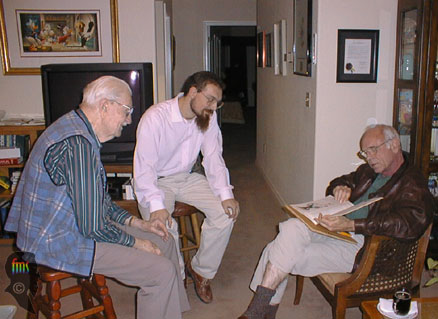
Another interesting thing that Helen did had to do with a therapeutic potion made from a tropical fruit called Noni, whose healthy virtues she extolled. I was offered a small glass to try, but I found the taste so horrible that I couldn't finish it. Carl, instead, drank his like a good boy. Since he had it regularly every day, his health and longevity would have probably made an excellent testimonial for the makers of this beverage.
I spent the morning interviewing Carl for the book about him I will write one day (probably with Leonardo again -- but this time it's got to be in English!). His nicest words were for his dear wife Garé. Hanging on the wall in front of us was a really beautiful painting of a mountain lake with deer. One of hers. "She was born with only this much of a left arm. No hand.", he told me. "When her parents saw the newborn baby without a hand, they cried." Then he pointed at the painting, explaining how she had to do everything she did, including of course painting, with just one hand. The love in his eyes, in his body language, in his words, was moving. He communicated the joy of the achievement of having created such beauty despite the handicap. "When her parents saw this, they cried." We both laughed, perhaps because we were about to cry too. He really made me feel the strength of their bond. It was beautiful.
Carl, Helen and I went out for lunch and had a good time. I seem to recall that we talked about our families. Back home, Carl had some rest in front of the television (he liked to watch sports programmes) and I went out for a little walk in the neighbourhood.
Later that afternoon Carl received the visit of another fan, a doctor called Richard Huemer, whose father (also Richard Huemer) had worked at Disney as an animator and had been story director for Fantasia. Richard had brought with him two interesting artefacts from his father's things: a piece of original artwork from Snow White and a wonderful sketchbook. In the photograph he is showing us something from the sketchbook and under it he holds the framed artwork in his lap. Gerry also joined us, bringing along some yummy takeaway food (roast chicken or something like that) and we spent an enjoyable evening around the dinner table discussing subjects ranging from animation to travelling to medicine to cryptography.
The next morning Carl, Gerry, Helen and I went out for breakfast,
which I thought was a real treat! Eggs, pancakes and other delicious
things that I considered fairly exotic (in fact, very comic-book-like)
for a breakfast. These were our last few hours together and I felt as
if I were in a beautiful dream with the sad sensation that I was soon
going to wake up. I told Carl about a vivid memory from my childhood
of diving in a mountain of golden wheat when I was perhaps 6 or 7 (at
the time my grandfather owned some wheat fields), and burrowing in it
like a gopher, and tossing it in the air thinking that I was like
Uncle Scrooge.
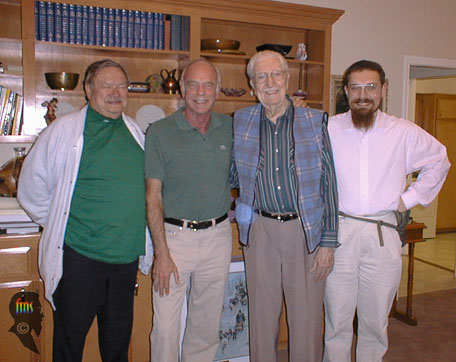
As we got back home, while Carl was coming out of the car a coin fell out of his pocket. I picked it up and gave it to him, but he told me to keep it. "My lucky dime!", I said, "given to me by the creator of Uncle Scrooge!". One day I will get hold of two velvet cushions and two glass bells (I already have two eminently suitable marble columns -- I inherited them from my grandparents) and I will place my two lucky dimes where they belong. The other one, in case you are wondering, is an 1875 coin given to me by Don Rosa.
Back at home I met a third helper of Carl, Anja, who had just spent the weekend in Las Vegas with her boyfriend. She had some good Vegas anecdotes for us.
Gerry, Helen and Carl drove me to the airport and the time came to say goodbye. I flew off to my computer conference in Texas, leaving it one day earlier to go to the presentation of my Gottfredson book in Italy. When I finally came back home to Cambridge I was exhausted and drained of all energy, but happy: I had just lived through some of the most intense days of my life. No words can completely describe the ecstatic feeling I experienced during these short days. And it had also been heartwarming to witness the love and care with which the people near Carl looked after him.
I will never forget the emotion of spending that weekend with Carl Barks. Here is one of the greatest men I have ever known, and yet he is so modest and unassuming. I am only one out of millions of people in the world who are fascinated by his creations, but he makes me feel like a most special guest and he welcomes me like a prince. He has a kind heart and a generous, contagious smile. As I wrote to him shortly after my visit:
Your ducks will always be there as the testimony of your genius. I trust that even hundreds of years from now they will still be reprinted as the great classics that they are. You are already immortal as author, artist, narrator. What not many people know is how nice and kind you are as a human being. I wish I had kids so that I could read them your comics and later tell them about you, and inspire their hearts with the story of this humble, honest, hard-working man that put a smile on so many millions of faces, generation after generation, and yet remained so innocent and modest about himself. [...] I'll never forget this visit. And, unless you decide at the time that you have more important commitments, as in fact you well deserve, I promise I'll be back to take you out for a nice celebration dinner when the clock reaches the end of its countdown.
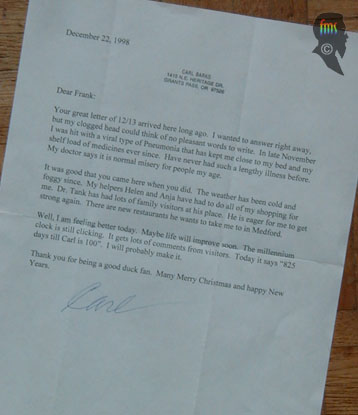
His reply, written a few days before Christmas 1998, mentioned a nasty pneumonia that hit him a couple of weeks after my visit, and from which he was just recovering:
Well, I am feeling better today. Maybe life will improve soon. The millennium clock is still clicking. It gets lots of comments from visitors. Today it says "825 days till Carl is 100". I will probably make it.
He almost did. But leukaemia attacked him in 1999, slowly and methodically destroying his blood cells; a year later his health started to deteriorate fairly rapidly and he asked, with the dignity and wisdom that were so deeply engrained in his character, that the medications that were prolonging his life be stopped. Gerry acted as a bridge between his fans on the Internet and him, forwarding many emails of encouragement, gratefulness and love. Carl died a couple of months later, on the 25th of August 2000, aged 99. I could not help thinking about the King Khan Khan of one of his last and most powerful stories (despite the Tony Strobl artwork) who, after having lived for millennia, voluntarily chose to eat the antidote to the blue immortality powder.
The text and all the photographs with the fms silhouette logo are
Copyright © Frank Stajano.
Any pictures of Disney characters
are Copyright © Walt Disney Company.
Back to Frank's Disney Comics page.